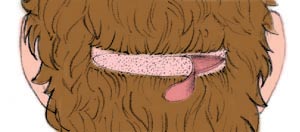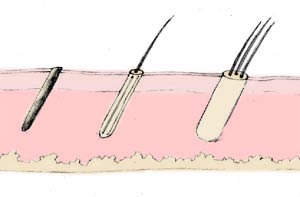The hairline itself can indicate if a person is male or female.
It also determines the choice of hairstyle for each gender. A receding hairline shaped as an M is typically male and may prevent you from doing your hair the way you like. On the other hand, a low hairline shaped like an inverted U is a typically female hairline and gives you the freedom of choosing the hairstyle you want.
We are not offering this service currently, so this page is just for guidance and intended for you to learn about the procedure.
You may not be familiar with the terms used in this field. That is why we would like to present the information clearly and in detail, explaining one by one each of the concepts that will arise as we describe the successive stages of the procedure; we hope this will help you make decisions with a better judgment.
The smallest capillary unit is the follicular unit, which does not consist only of hair roots (follicles), but also of sebaceous and sudoriferous glands, and minute webs of nerves and blood vessels. In order for the implant to be successful,this unit must remain intact. Each follicular unit may consist of more than one hair. This means that, when we transplant a follicular unit, we may be transplanting one, two, or three hairs. In average, the number of transplanted hairs during one session of follicular micrografting is a little more than twice the number of follicular units transplanted. Therefore, 1,000 UF (follicular units) will result in 2,000 or 2,500 transplanted hairs.
Follicular micrografting, is the action of implanting follicular units (with one, two, three or four hairs each) in an area where they did not originally belong, transplanting them from their original area of growth. The micrografts are never rejected by the body because they are collected from the same patient.
Healthy hairs will still grow where they are implanted.
The hairs on the side and back of the head are genetically programmed to be healthy throughout their life. But the genetic information of the hairs located on the top of the head makes them very sensible to male hormones, which trigger an early interruption of their life cycle and make them fall. From the observation of this pattern of hair growth, the following theory has been elaborated: if a hair from the back of the head is transplanted to the front, it will keep the strength and genetic information that will allow it to live for as long as it would have lived in its original place. This theory is correct, as long as the procedure is done taking the necessary precautions. If a follicular unit is damaged during the procedure, weak hairs may grow from it or they may not grow at all.
Our team is aware that perennial hairs are a scarce and limited resource and that they should not be squandered. There is only a limited number of available hairs that are fit for transplant: once they are all used, there is no way of getting more. That is why, to make sure that the highest possible number of transplanted hairs will survive, we use the most precise equipment for collecting the follicles from the back of the head, processing them in an ideal culture medium at an adequate temperature, and implanting them into other areas of the head.
Our medical team has achieved and keeps a survival rate of collected follicles of 96%.
Before the procedure, the surgeon makes a prognosis of how the scalp will evolve in the long term. Fortunately, hormone replacement therapies stop the deteriorating process of the hair, but generally the hair lost doesn't grow by itself again. If an area of your head shows signs of irreversible hair loss, the surgeon will place the micrografts as though the area was already bald.
The surgeon shaves a horizontal strip of hair on the area of permanent hair growth, that is, on the sides or on the back of the head. He surgically removes the shaved strip of skin, usually of about 0.6 inches (1.5 cm) wide and between 5.5 inches and 7 inches (14 cm and 18 cm) long, and sutures the edges of the resulting wound.


The auxiliary team removes the follicular units from the strip of skin, aided with special optical instruments. This way, the follicular units collected are ready for implantation.
Those consisting of one or two hairs will give the most natural results, but they provide less density. Those of three or four hairs, on the other hand, are very useful in the areas where density is the most important factor. If only units of just one hair were implanted in all the head, when exposed to back lights or when we walk beneath ceiling lamps, for example, the hair will look translucent.

Each follicular unit can have one, two, three or more hairs.
Approximately, 33 hairs per square centimeter are implanted.
A lower density would be insufficient, whereas a higher density would result in excessive pressure upon the scalp and a subsequent rejection of some of the transplanted units. If you wish higher density, you may resort to a second session to have new hairs implanted between those that were implanted in the first one, but you must wait for them to grow and get strong.
In each session, it is possible to transplant about 2500 UF (between 4000 and 6000 hairs).
Anesthesia
The procedure is performed under local anesthesia, and mild oral sedation if needed.
How long will it take?
About 4 or 6 hours.
How long will I have to stay hospitalized?
There is not need to be hospitalized. It is done on an outpatient basis.
What kind of bandages will I need, when will they be removed?
No bandages are needed.
Will I feel a lot of pain?
The pain is very mild and, if you take the analgesics prescribed by the surgeon, you will feel much relieved. You will probably have a feeling of tightness on the donor area, from where the strip of skin was removed.
When will the stitches be removed?
The stitches on the donor area are removed a week after the transplant.
What will the scars look like?
The small perforations where each follicular unit is implanted become invisible very soon. A small scab will develop on each microimplant, but it will fall off by itself after a week. The scar on the donor area remains completely hidden by the hair.
Recovery period
You will have to rest at the hotel for 24 hours.
After 48 hours, you will be able to wash your head following the instructions of the physician to prevent scab formation on the donor area, and taking care not to damage the area with the implants. You will be able to wash your head as usual 7 days after the treatment. For a month, you shouldn’t expose your head to the sun, not because the sun in itself will do any harm to the implants, but to prevent accidentally scratching your head.
During the first 2 or 3 days, you should sleep with your head elevated to reduce the inflammation and ease the healing process.
During the first 24 hours, there will probably not be any visible signs of inflammation. After 48 hours, the forehead swells and an edema that may migrate to the eyebrows and eyelids will develop.
Don’t worry if you see that the transplanted hairs fall. t’s normal. The roots are still healthy but dormant. Usually, 80% of the transplanted hair falls, but the other 20% doesn’t fall and remains dormant. After about 3 months, the follicles become active again and the hair begins to grow in its new place at a rate of about 0.4 inches to 0.6 inches (1 cm to 1.5 cm) per month.
During a year, these hairs will be thicker that they were when they were growing in their original place, but they become normal again.
Once the transplanted hairs have recovered their vitality, it’s possible to perform a second session for higher density, if the patient is not satisfied.
The genetic information of your transplanted hairs will make them continue growing all your life, no matter where they are located.
Follicular micrografting will give your face a feminine touch. They also cover bald areas on the top of your head. Your hair will be distributed according to a feminine pattern of hair growth, and you will be free to comb your hair the way you like.
The number of transplants needed depends on the person and is determined by the area to be covered. It is important to stress that, in all cases, the surgeon will aim at reaching the highest possible density. However, how it will look will not depend only upon the number of "real" hair transplanted, but upon other facts such as the average thickness of the hair, the hair’s undulation, the degree of contrast between the hair and the skin, and the number of hairs per follicular unit. It’s also very important to take into account the number of available hair on the donor area.
To give you an adequate estimate of your needs, please send us a set of pictures showing well-lit close-ups of your head from all angles: front, back and above.
The pictures will help us calculate accurately the number of micrografts you will need and inform you the treatment’s cost.